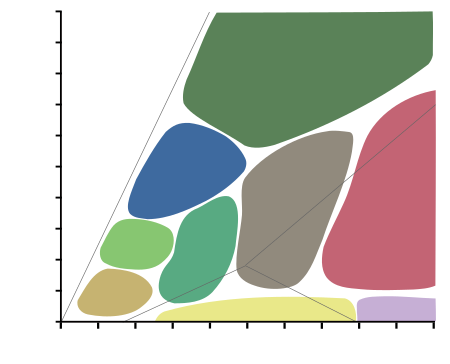User:Marshallsumter/Keynote lectures (draft)/Geology

At its earliest, geology is the study of the rocks that compose the astronomical rocky object referred to as the Earth.
Whether the earliest hominins conceived of the Earth as approximating a spheroidal rocky object is unknown.
Radioactivity edit
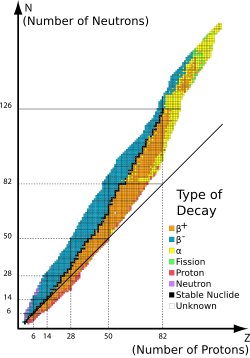

Def. a spontaneous emission of an α ray, β ray, or γ ray by the disintegration of an atomic nucleus is called radioactivity.[1]
Although alpha, beta, and gamma radiations were found most commonly, other types of decay were eventually discovered. Shortly after the discovery of the positron in cosmic ray products, it was realized that the same process that operates in classical beta decay can also produce positrons (positron emission). In an analogous process, instead of emitting positrons and neutrinos, some proton-rich nuclides were found to capture their own atomic electrons (electron capture), and emit only a neutrino (and usually also a gamma ray). Each of these types of decay involves the capture or emission of nuclear electrons or positrons, and acts to move a nucleus toward the ratio of neutrons to protons that has the least energy for a given total number of nucleons (neutrons plus protons).
Radioactive decay is a stochastic (i.e., random) process at the level of single atoms, in that, according to quantum theory, it is impossible to predict when a particular atom will decay.[2] However, the chance that a given atom will decay is constant over time. For a large number of atoms, the decay rate for the collection is computable from the measured decay constants of the nuclides (or equivalently from the half-lifes).
Radioactive primordial nuclides found in the Earth are [probably] residues from ancient supernova explosions which occurred before the formation of the solar system. They [may be] the long-lived fraction of radionuclides surviving in the primordial solar nebula through planet accretion until the present. The naturally occurring short-lived radiogenic radionuclides found in rocks [may be] the daughters of these [radioactive] primordial nuclides. Another minor source of naturally occurring radioactive nuclides are cosmogenic nuclides, formed by cosmic ray bombardment of material in the Earth's atmosphere or crust. Radionuclides can also be produced artificially e.g. using particle accelerators or nuclear reactors.
Although the Earth's field is generally well approximated by a magnetic dipole with its axis near the rotational axis, there are occasional dramatic events where the North and South geomagnetic poles trade places. These events are called geomagnetic reversals. Evidence for these events can be found worldwide in basalts, sediment cores taken from the ocean floors, and seafloor magnetic anomalies. Reversals occur at apparently random intervals ranging from less than 0.1 million years to as much as 50 million years. The most recent such event, called the Brunhes–Matuyama reversal, occurred about 780,000 years ago.[3][4]
The longer the period of geomagnetic reversal the longer the Earth's surface rocks receive a heightened exposure to solar and galactic cosmic rays that in turn may make these rocks appear older than they are.
Planetary sciences edit
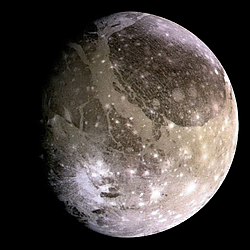
Planetary science studies the effects on astronomical objects of being in an orbit around another object within a few light years.
Colors edit

The rocks, regolith, and sediment of the Earth reflect colors and a variety of radiation.
Minerals edit

Minerals are solid inorganic substances of natural occurrence.
As of May 2017, there are "5256 currently valid species" approved by the International Mineralogical Association (IMA).[5]
The "main oxides present in cement – CaO, SiO2, Al2O3, Fe2O3 – constitute over 90% of the earth's crust."[6]
Mineralogy edit

Def. the scientific study of minerals is called mineralogy.
Grains of hibonite found in meteorites have a bluish cast like the specimen of blue hibonite from Madagascar in the image on the right suggesting similar origins.
Alkali metal minerals edit

Various minerals contain significant amounts of the alkali metals: Li, Na, K, Rb, and Cs. Trace amounts of Fr do occur.
Alkaline earth metal minerals edit

The elements Be, Mg, Ca, Sr, Ba, and Ra are common in minerals such as calcite which makes up rocks such as limestone and dolomite.
Beryllium occurs in a hexgonal close-packed (hcp) crystal structure at room temperature (α-Be).
As indicated in the phase diagram on the left beryllium occurs as (β-Be) which is bcc at higher temperatures up to melting.
Native beryllium is not known to occur on the surface of the Earth, but may eventually be found among beryllium-bearing minerals in small amounts.
Chalcogen minerals edit


The chalcogen minerals contain significant quantities of oxygen, sulfur, selenium, tellurium and polonium. Quartz is composed of SiO2. Two atoms of oxygen are present for one atom of silicon.
Native sulfur is a naturally occurring chalcogen mineral.
Def. a continuous framework tectosilicate of SiO4 silicon–oxygen tetrahedra, with each oxygen being shared between two tetrahedra, giving an overall chemical formula of silicon dioxide SiO2 of trigonal trapezohedral class 3 2, usually with some substitutional or interstitial impurities, is called α-quartz.
Gems edit

Many minerals occur in large enough crystals to be considered gems.
Def. a "precious stone, usually of substantial monetary value or prized for its beauty or shine"[7] is called a gem.
Def. the "art and science of gems"[8] is called gemology.
Halogens edit

Def. any "element of group 7, i.e. fluorine, chlorine, bromine, iodine and astatine, which form a salt by direct union with a metal"[9] is called a halogen.
Fluorite is a mineral composed of NaF.
Metal minerals edit

Def. any "of a number of chemical elements in the periodic table that form a metallic bond with other metal atoms; generally shiny, somewhat malleable and hard, often a conductor of heat and electricity"[10] is called a metal.
Kamacite is an alloy of iron and nickel, which is only found on earth in meteorites. The proportion iron:nickel is between 90:10 to 95:5; small quantities of other elements, such as cobalt or carbon may also be present. The mineral has a metallic luster, is gray and has no clear cleavage although the structure is isometric-hexoctahedral. Its density is around 8 g/cm³ and its hardness is 4 on the Mohs scale. It is also sometimes called balkeneisen.
Precious metal minerals edit

Def. a "rare metallic chemical element of high economic value"[11] is called a precious metal.
Rare earth minerals edit
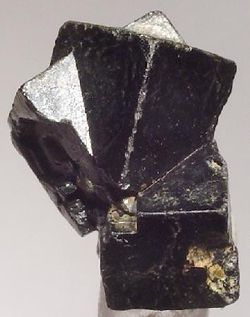
Def. "naturally occurring oxides of the lanthanide metals"[12] are called rare earths.
Thorianite is a rare thorium oxide mineral, ThO2.[13] It has a high percentage of thorium; it also contains the oxides of uranium, lanthanum, cerium, praseodymium and neodymium. The mineral is slightly less radioactive than pitchblende, but is harder to shield due to its high energy gamma rays. It is common in the alluvial gem-gravels of Sri Lanka, where it occurs mostly as water worn, small, heavy, black, cubic crystals.
Silicate minerals edit
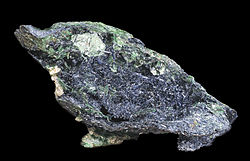
Often a mineral appears blue due to the presence of copper or sulfur. Glaucophane is a blue silicate that owes its color to its characteristic formation.
Def. any "salt of silica or of one of the silicic acids"[14] is called a silicate.
Def. any group of silicates that have structurally isolated double tetrahedra is called a sorosilicate.
Def. any group of silicates that have a ring of linked tetrahedra is called a cyclosilicate.0-582-30094-0Mineralogically, silicate minerals are divided according to structure of their silicate anion into the following groups:[15][16]
- Nesosilicates (lone tetrahedron) - [SiO4]4−, e.g. olivine, tephroite.
- Sorosilicates (double tetrahedra) - [Si2O7]6−, e.g. epidote, melilite group, leucophanite.
- Cyclosilicates (rings) - [SinO3n]2n−, e.g. tourmaline group.
- Inosilicates (single chain) - [SinO3n]2n−, e.g. pyroxene group.
- Inosilicates(double chain) - [Si4nO11n]6n−, e.g. amphibole group.
- Phyllosilicates (sheets) - [Si2nO5n]2n−, e.g. micas and clays like Kaolin.
- Tectosilicates (3D framework) - [AlxSiyO2(x+y)]x−, e.g. quartz, feldspars, zeolites.
Def. the "oxyanion of silicon SiO32- or any salt or mineral containing this ion"[17] is called a metasilicate.
Transuranic minerals edit

Def. any naturally occurring element "lying beyond uranium in the periodic table; having an atomic number greater than 92"[18] is called a transuranic.
Minerals containing transuranics are not rare. But, the stability of such isotopes makes it unlikely to find large concentrations of specific elements.
The transuranics start after uranium (U) in the periodic table. They include the named elements: plutonium (Pu), americium (Am), curium (Cm), berkelium (Bk), californium (Cf), einsteinium (Es), fermium (Fm), mendelevium (Md), nobelium (No), lawrencium (Lr), rutherfordium (Rf), dubnium (Db), seaborgium (Sg), bohrium (Bh), hassium (Hs), meitnerium (Mt), darmstadtium (Ds), roentgenium (Rg), copernicium (Cn), flerovium (Fl), and livermorium (Lv).
Crystallography edit
Def. # an "experimental science of determining the arrangement of atoms in solids"[19], or
- the "study of crystals"[19] is called crystallography.
| Ih, order 120 | |||
|---|---|---|---|
| Regular- | Small stellated- | Great- | Great stellated- |
 |  |  |  |
| Th, order 24 | T, order 12 | Oh, order 48 | Td, order 24 |
| Pyritohedron | Tetartoid | Rhombic- | Trapezoidal- |
 |  |  |  |
| D4h, order 16 | D3h, order 12 | ||
| Rhombo-hexagonal- | Rhombo-square- | Trapezo-rhombic- | Rhombo-triangular- |
 |  |  |  |
Mineraloids edit

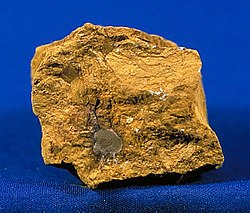
Def. a "substance that resembles a mineral but does not exhibit crystallinity"[20] is called a mineraloid.
Def. a "small, round, dark glassy object, composed of silicates"[21] is called a tektite.
Def. a "hard, generally yellow to brown translucent fossil resin"[22] is called an amber.
Def. a naturally occurring black glass is called an obsidian.
Def. a naturally occurring, hydrous, amorphous form of silica, where 3% to 21% of the total weight is water is called an opal.
Limonite is an iron ore consisting of a mixture of hydrated iron(III) oxide-hydroxides in varying composition. The generic formula is frequently written as FeO(OH)·nH2O, although this is not entirely accurate as the ratio of oxide to hydroxide can vary quite widely. Limonite is one of the two principle iron ores, the other being hematite, and has been mined for the production of iron since at least 2500 BCE.[23][24] Although originally defined as a single mineral, limonite is now recognized as a mixture of related hydrated iron oxide minerals, among them goethite, akaganeite, lepidocrocite, and jarosite. Individual minerals in limonite may form crystals, but limonite does not, although specimens may show a fibrous or microcrystalline structure,[25] and limonite often occurs in concretionary forms or in compact and earthy masses; sometimes mammillary, botryoidal, reniform or stalactitic. Because of its amorphous nature, and occurrence in hydrated areas limonite often presents as a clay or mudstone. However there are limonite pseudomorphs after other minerals such as pyrite.[26] This means that chemical weathering transforms the crystals of pyrite into limonite by hydrating the molecules, but the external shape of the pyrite crystal remains. Limonite pseudomorphs have also been formed from other iron oxides, hematite and magnetite; from the carbonate siderite and from iron rich silicates such as almandine garnets. Limonite usually forms from the hydration of hematite and magnetite, from the oxidation and hydration of iron rich sulfide minerals, and chemical weathering of other iron rich minerals such as olivine, pyroxene, amphibole, and biotite. It is often the major iron component in lateritic soils. One of the first uses was as a pigment. The yellow form produced yellow ochre for which Cyprus was famous,[27]
Theoretical geology edit

Def. the intellectual and practical activity encompassing the systematic study through observation and experiment of the Earth's physical structure and substance, its history and origin, and the processes that act on it, especially by examination of its rocks, is called geology.
Def. "the study of the planet earth- the materials it is made of, the processes that act on those materials, the products formed, and the history of the planet and its life forms since its origin"[28] is called geology.
Def. a "layer of loose rock, dust, sand, and soil, resting on the bedrock"[29] is called a regolith.
Reconstructions of seismic waves in the deep interior of the Earth show that there are no S-waves in the outer core. This indicates that the outer core is liquid, because liquids cannot support shear. The outer core is liquid, and the motion of this highly conductive fluid generates the Earth's field (see geodynamo).
A "kind of "jet stream" - a fast-flowing river of liquid iron [depicted with an artist's impression in the image on the right] is surging westwards under Alaska and Siberia."[30]
"The moving mass of metal has been inferred from measurements made by Europe’s Swarm satellites. [...] the jet is the best explanation for the patches of concentrated field strength that the satellites observe in the northern hemisphere."[30]
"This jet of liquid iron is moving at about fifty kilometres per year. That might not sound like a lot to you on Earth's surface, but you have to remember this a very dense liquid metal and it takes a huge amount of energy to move this thing around and that's probably the fastest motion we have anywhere within the solid Earth.”[31]
The "jet [is] about 420 km wide, and [...] wraps half-way around the planet."[30]
“It's likely that the jet stream has been in play for hundreds of millions of years."[32]
"It currently wraps about 180 degrees around the tangent cylinder [a boundary between two different regions in the core, a tube sitting around the solid inner core, running along Earth’s rotation axis]. Although observations only constrain the jet stream on the edge of the core, our theoretical understanding suggests that the jet could in principle go very deep indeed - possibly in fact all the way down to the edge of the core in the southern hemisphere (i.e. at the other end of the tangent cylinder)."[32]
"When liquid iron approaches the boundary from both sides, it gets squeezed out sideways to form the jet, which then hugs the imaginary tube."[30]
"Of course, you need a force to move fluid towards the tangent cylinder. This could be provided by buoyancy, or perhaps more likely from changes in the magnetic field within the core."[33]
Entities edit

Def. any "considerable and connected part of a space or surface; specifically, a tract of land or sea of considerable but indefinite extent; a country; a district; in a broad sense, a place without special reference to location or extent but viewed as an entity for geographical, social or cultural reasons"[34] is called a region.
Sources edit

Geological sources may be fluid substances.
The scene on the right was acquired by the Moderate Resolution Imaging Spectroradiometer (MODIS), flying aboard NASA’s Terra satellite, on October 23, 2002.
Objects edit

The image on the right shows calcite after Ikaite variety Glendonite as a concretion in this rock found on the Kola Peninsula, Russia.
An object in geology may be as simple as a stone or as complex as a product of orogeny.
Def. "the process of mountain building by the upward folding of the Earth's crust"[35] is called orogeny.
Gravity edit

Def. resultant "force on Earth's surface, of the attraction by the Earth's masses, and the centrifugal pseudo-force caused by the Earth's rotation"[36] is called gravity.
Most objects on the surface of the Earth appear to fall to lower elevations whenever possible. Hydrogen gas molecules (H2) and helium (He) atoms do not fall.
Meteors edit




Some meteors pass through the Earth's atmosphere but keep on going. Others impact the Earth as meteorites.
The largest known, or suspected, meteorites were asteroids.
In the image at left is an aerial view of the Barringer Meteor Crater about 69 km east of Flagstaff, Arizona USA. Although similar to the aerial view of the Soudan crater, the Barringer Meteor Crater appears angular at the farthest ends rather than round.
Meteor Crater is a meteorite impact crater approximately 43 miles (69 km) east of Flagstaff, near Winslow in the northern Arizona desert of the United States. Because the US Department of the Interior Division of Names commonly recognizes names of natural features derived from the nearest post office, the feature acquired the name of "Meteor Crater" from the nearby post office named Meteor.[37] The site was formerly known as the Canyon Diablo Crater, and fragments of the meteorite are officially called the Canyon Diablo Meteorite. Scientists refer to the crater as Barringer Crater in honor of Daniel Barringer, who was first to suggest that it was produced by meteorite impact.[38]
From space the crater appears almost like a square. The image at right has a resolution of 2 meters per pixel, and illumination is from the right. Layers of exposed limestone and sandstone are visible just beneath the crater rim, as are large stone blocks excavated by the impact.
The Holsinger meteorite is the largest discovered fragment of the meteorite that created Meteor Crater and it is exhibited in the crater visitor center. The Canyon Diablo meteorite comprises many fragments of the asteroid that impacted at Barringer Crater (Meteor Crater), Arizona, USA. Meteorites have been found around the crater rim, and are named for nearby Canyon Diablo, which lies about three to four miles west of the crater. There are fragments in the collections of museums around the world including the Field Museum of Natural History in Chicago. The biggest fragment ever found is the Holsinger Meteorite, weighing 639 kg, now on display in the Meteor Crater Visitor Center on the rim of the crater.
Visuals edit

Def. a "portion of land or territory which the eye can comprehend in a single view, including all the objects it contains"[39] is called a landscape.
Def. each continuous surface of a landscape that is observable in its entirety and has consistence of form or regular change of form is called a landform.
Inert gas minerals edit

Def. any "monatomic and (with very limited exceptions) inert"[40] gas is called a noble gas.
The elemental noble gases are helium, neon, argon, krypton, xenon, and radon. These occur from the radioactive decay of other elements. Various trace levels of these gases occur in minerals. Helium is often recovered from traps above salt domes.
"Confirmation of the source of excess argon comes from step-heating experiments on multiple anorthoclase aliquots separated from two phenocrysts and one glass aliquot prepared from the matrix of a volcanic bomb."[41]
The image on the right shows the geographic locations within the United States of helium-rich gas fields.
Liquid objects edit

Water occurs on land, composes the oceans, becomes ice and forms clouds. All of these are part of hydrology.
Def. a naturally occurring, silvery-colored, metallic liquid, composed primarily of the chemical element mercury, is called mercury, or native mercury.
Native mercury (Hg) occurs as a liquid. Gallium (Ga) melts just above room temperature.
A division of astronomical objects between rocky objects, liquid objects, gaseous objects (including gas giants and stars), and plasma objects may be natural and informative.
Hydrology edit

Def. the "science of the properties, distribution, and effects of water on a planet's surface, in the soil and underlying rocks, and in the atmosphere"[42] is called hydrology.
Geohydrology edit


The discoveries of the locations of water may be thought of as geohydrology.
At the right is an "aerial view [of] thermokarst lakes outside the town of Chersky in northeast Siberia [on] August 28, 2007."[43]
Def. "a lake occupying a closed depression formed by settlement of the ground following thawing of ice-rich permafrost or the melting of massive ice"[44] is called a thermokarst lake.
Hydromorphology edit

Hydromorphology is the science of the shapes and forms of water on Earth.
Oceans edit
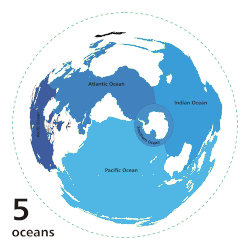
Def. On Earth one "of the five large bodies of water separating the continents"[45] is called an ocean.
Oceanography edit
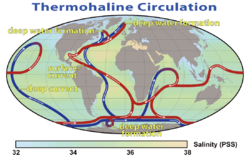
Oceanography, also called oceanology or marine science, studies the ocean. It covers a wide range of topics, including marine organisms and ecosystem dynamics; ocean currents, waves, and geophysical fluid dynamics; plate tectonics and the geology of the sea floor; and fluxes of various chemical substances and physical properties within the ocean and across its boundaries.
Petroleums edit

Def. a "flammable liquid ranging in color from clear to very dark brown and black, consisting mainly of hydrocarbons, occurring naturally in deposits under the Earth's surface"[46] is called petroleum.
Rocky objects edit

Def. full "of, or abounding in, rocks; consisting of rocks... [l]ike a rock"[47] is called rocky.
Def. a solid, or rocky, surface of an astronomical rocky object is called land.
Def.
- a "single, distinctive rock formation",[48]
- "an area having a preponderance of a particular rock or group of rocks",[48] or
- an "area of land or the particular features of it"[48]
is called a terrain.
Def. the "physical structure of a particular region [or] terrain"[49] is called geography.
Coals edit

Def. a "black rock formed from prehistoric plant remains, composed largely of carbon and burned as a fuel"[50] is called a coal.
Types of coal include: "bituminous, anthracite, or lignite, and grades and varieties thereof."[50]
Ices edit

Def. any frozen "volatile chemical, such as water, ammonia, or carbon dioxide"[51] is called an ice.
Ice cores edit
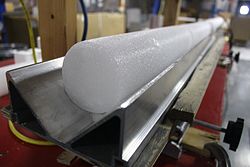
An ice core is a cylindrical sample of a rocky object consisting mostly of water ice. As shown in the image at the right, the long axis is in the direction of the coring into the object from its outer surface.
An ice core is taken with a hollow drill supported by a rig.
Def. "a core sample drilled from the accumulation of snow and ice over many years that have recrystallized and have trapped air bubbles from previous time periods, the composition of which can be used to reconstruct past climates and climate change; typically removed from an ice sheet (Antarctica and Greenland) or from high mountain glaciers elsewhere"[52] is called an ice core.
Ice sheets edit

Def. "a dome-shaped mass of glacier ice that covers surrounding terrain and is greater than 50,000 square kilometers (12 million acres)"[52] is called an ice sheet.
Astroglaciology edit

Astroglaciology is the observation and interpretation of glacial structures on rocky objects such as Ganymede from above.
Rocks edit

Def. any "natural material with a distinctive composition of minerals"[53] is called a rock.
Igneous rocks edit

A rhyolite boulder on the right near Carn Alw shows the characteristic pattern of swirling or parallel layers called flow banding caused by the molten magma meeting a hard surface before cooling and setting.
Def. a group of rocks "formed by the cooling of molten rock, either below the surface (intrusive) or on the surface (extrusive)"[54] is called an igneous rock.
Volcanology edit

Volcanology is the scientific study of volcanoes.
Volcanoes edit


An eruption of Mount Asama in Tsumagoi, about 140 km (87 miles) northwest of Tokyo, is imaged.
On the left is a lava flow. Lava is an extrusive form of magma.
Tephra layers edit

The rhythmically layered, dark gray material visible in the wall on the right consists of more than 15 m (50 ft) of phreatomagmatic tephra. The 1977 tephra sits on an exposure of glacial till capping ash-flow deposits from the Ugashik Caldera.
Magmas edit


Def. "molten matter within the earth, the source of the material of lava flows, dikes of eruptive rocks, etc"[55] is called magma.
Def. a "fine-grained [...] rock composed mostly of pyroxene and feldspar"[56] is called a diabase.
Metamorphism edit

Def. any "process by which rocks are changed into other forms"[57] is called metamorphism.
Def. a "rock containing glaucophane"[58] is called a blueschist.
| Diagram showing metamorphic facies in pressure-temperature space. The domain of the graph corresponds to circumstances within the Earth's crust and upper mantle. |
A metamorphic facies is a set of metamorphic mineral assemblages that were formed under similar pressures and temperatures.[59] The assemblage is typical of what is formed in conditions corresponding to an area on the two dimensional graph of temperature vs. pressure (See diagram at right).[59] Rocks which contain certain minerals can therefore be linked to certain tectonic settings, times and places in geological history of the area.[59] The boundaries between facies (and corresponding areas on the temperature v. pressure graph), are wide, because they are gradational and approximate.[59] The area on the graph corresponding to rock formation at the lowest values of temperature and pressure, is the range of formation of sedimentary rocks, as opposed to metamorphic rocks, in a process called diagenesis.[59]
Blueschist is a metavolcanic rock that forms by the metamorphism of basalt and rocks with similar composition at high pressures and low temperatures, approximately corresponding to a depth of 15 to 30 kilometers and 200 to ~500 degrees Celsius. The blue color of the rock comes from the presence of the mineral glaucophane. Blueschists are typically found within orogenic belts as terranes of lithology in faulted contact with greenschist or rarely eclogite facies rocks. Blueschist, as a rock type, is defined by the presence of the minerals glaucophane + ( lawsonite or epidote ) +/- jadeite +/- albite or chlorite +/- garnet +/- muscovite in a rock of roughly basaltic composition. Blueschist often has a lepidoblastic, nematoblastic or schistose rock microstructure defined primarily by chlorite, phengitic white mica, glaucophane, and other minerals with an elongate or platy shape. Grain size is rarely coarse, as mineral growth is retarded by the swiftness of the rock's metamorphic trajectory and perhaps more importantly, the low temperatures of metamorphism and in many cases the anhydrous state of the basalts. However, coarse varieties do occur. Blueschists may appear blue, black, gray, or blue-green in outcrop.
Metamorphic rocks edit

Def. a group of rocks that "consists of pre-existing rock mass in which new minerals or textures are formed"[60] is called a metamorphic rock.
Sedimentology edit

Sedimentology encompasses the study of modern sediments such as sand,[61] mud (silt),[62] and clay,[63] and the processes that result in their deposition.[64]
Soils edit

Pedology is concerned with the formation, nature, ecology, and classification of soils.
Sedimentary rocks edit
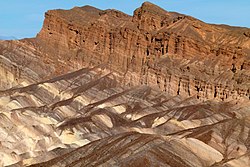
Sedimentary rocks cover most of the Earth's surface, record much of the Earth's history, and harbor the fossil record. Sedimentology is closely linked to stratigraphy, the study of the physical and temporal relationships between rock layers or strata.
Def. a group of rocks "formed by the deposition of either the weathered remains of other rocks, the results of biological activity, or precipitation from solution"[65] is called a sedimentary rock.
Meteorites edit

Meteorites occur over all the Earth's surface but are only easily found or preserved in specific environments.
Def. "a meteor that reaches the surface of the Earth without being completely vaporized" is called a meteorite.[1]
Def. "a metallic or stony object or body that is the remains of a meteor"[67] is called a meteorite.
Micrometeorites edit
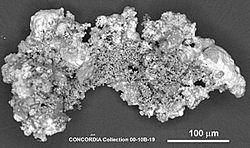
Micrometeorite is often abbreviated as MM. Most MMs are broadly chondritic in composition, meaning "that major elemental abundance ratios are within about 50% of those observed in carbonaceous chondrites."[68] Some MMs are chondrites, (basaltic) howardite, eucrite, and diogenite (HED) meteorites or Martian basalts, but not lunar samples.[68] "[T]he comparative mechanical weakness of carbonaceous precursor materials tends to encourage spherule formation."[68] From the number of different asteroidal precursors, the approximate fraction in MMs is 70 % carbonaceous.[68] "[T]he carbonaceous material [is] known from observation to dominate the terrestrial MM flux."[68] The "H, L, and E chondritic compositions" are "dominant among meteorites but rare among micrometeorites."[68]
"Ureilites occur about half as often as eucrites (Krot et al. 2003), are relatively friable, have less a wide range of cosmic-ray exposure ages including two less than 1 Myr, and, like the dominant group of MM precursors, contain carbon."[68]
Glaciers edit

Hypothesis:
- Glaciers occur in every 10° of longitude around the globe and in every 5° of latitude from pole to pole.
Glaciology edit

Def. the "study of ice and its effect on the landscape, especially the study of glaciers"[69] is called glaciology.
Planetary geology edit

Planetary geology, astrogeology or exogeology, is a planetary science concerned with the geology of the celestial bodies such as the planets and their moons, asteroids, comets, and meteorites. It includes determining the internal structure of the terrestrial planets, planetary volcanism and surface processes such as impact craters, fluvial and aeolian processes.
Planetary geology is primarily the study of the geologic effects on a rocky object due to its being in orbit within a few light years of another object.
Earth edit

At the south pole, Antactica, there is also an extensive ice sheet in the image on the right. Apparently, when the North polar sea ice and ice sheet have been contracting, the South polar sea ice and ice sheet have been expanding.
Rocky object Earth edit

The Pacific Ocean covers almost half of the Earth's surface. Above is a map of the rocky-object features that form the bottom of the Pacific.
Craters edit





Meteorites often create and occur within impact craters. But, meteorites are not the only moving objects that crater or gouge the Earth's surface or interior.
The Nastapoka arc is a geological feature located on the southeastern shore of Hudson Bay, Canada.
It is a near-perfect circular arc, covering more than 160° of a 450 km diameter circle.
"C. S. Beals (1968) suggested that the Hudson Bay arc is the remnant rim of a giant impact crater nearly 300 miles across, or comparable to Mare Crisium in size."[70]
"Although extensive clean rock exposures abound, no shatter coning was observed."[70]
"[S]uevite-type or other unusual melt rocks, pseudotachylite or mylonite, radial faults or fractures, unusual injection breccias, and other possible shock metamorphic effects [were searched for, but] [n]one was found."[70]
Deitz' "negative results, however, probably do not disprove an impact origin for the arc, as even shatter coning, which is the lowest level shock indicator, still requires over-pressures from 20 to 50 kbars."[70]
"[A]n Archean impact might be forever buried beneath the Proterozoic sedimentary cover which filled the entire basin inside the postulated rim."[70]
From the high degree of circularity of the Nastapoka arc for more than 160°, the area of Hudson Bay where the arc occurs is part of a crater. But, what happened to the western 55 % of the crater? And, of course, what is the origin of the crater?
Looking at the image above right, where Quebec is in red, there are the Belcher Islands, also in the image at lower left, almost within a chord connecting the two ends of the arc. Putting a circle holometer over the arc shows that the center of the circle is slightly north-north west of the Belcher Islands and does not touch them.
With respect to the paleoproterozoic orogens, all of the arc just beyond the chord connecting the upper and lower latitude tips of the arc is considered part of the continental margin for the Trans-Hudson orogen to the west.[71]
The bay just north of that which is the bay of the Nastapoka arc is less circular and only about 90° of a circle. Up the same coast, the third inlet is also circular and about 80°.
The rock layers composing the Belcher Islands are not horizontal but may be dipping near vertically. If a cratering event occurred after the rock beds were tilted nearly on edge, the damage to the rock strata may have been more absorbed with less actual crater depth.
As at least half of each circle on the western half is missing, it may be that the craters are dipping downward to the west. The amount of dip is likely less than 10° so as to keep the craters from being ellipsoidal.
Craters initially circles dipping to the west result in a horizontal shortening of the W-E axis, while the N-S axis remains unchanged. The mountains of the eastern rim of the crater appear to decrease in relative elevation trending northward or southward around the arc from almost due east.
The more likely possibility is that the western halves have fallen or been depressed into the Earth approximately vertically. This would have the effect of maintaining circularity while causing a loss of the western half of each crater.
Speleology edit

Def. a "scientific study of caves"[72] is called speleology.
Earth sciences edit

Def. any "of the sciences dealing with the planet Earth"[73] is called an earth science.
Economic geology edit

Def. a geology of Earth materials that are a focus for extractive industries is called economic geology.
Mining edit

The image at right shows a sluice box for placer mining. This mining benefits from economic geology.
Def. an "activity of removing solid valuables from the earth"[74] is called mining.
Geochemistry edit

Geochemistry is the study of the chemical composition of the Earth and its rocks and minerals.
Geochronology edit
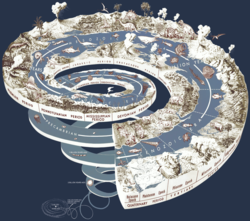
Def. the "science of dating samples of rock or sediment"[75] is called geochronology.
Geodesy edit

Def. "the geological science of the shape and size of the earth"[76] is called geodesy.
The image shows meridian convergence and spherical excess as part of geodesy.
Geodetics edit

Geodetics is geodesy as applied to land surveying.
Def. "the scientific discipline that deals with the measurement and representation of the earth, its gravitational field and geodynamic phenomena (polar motion, earth tides, and crustal motion) in three-dimensional, time-varying space"[77] is called geodetics.
Geognosy edit


Def. a "geological study of the Earth's structure and composition"[78] is called a geognosy.
Geology of the interior of Earth:
3. upper mantle
4. lower mantle
5. outer core
6. inner core
A: Mohorovičić discontinuity (Moho boundary)
C: Lehmann discontinuity (inner core-outer core boundary)
The Earth has an outer silicate solid crust, a highly viscous mantle, a liquid outer core that is much less viscous than the mantle, and a solid inner core. The Inner Core of the earth is believed to be composed primarily of a nickel-iron alloy, with very small amounts of some other elements.[79] The Outer Core of the earth is a liquid layer made of iron and nickel.
Geomorphology edit

Def. the "study of landforms, their classification, origin, development, and history"[80] is called geomorphology.
Astrogeology edit

Def. the intellectual and practical activity encompassing the systematic study through observation and experiment of naturally occurring astronomical rocky objects, their physical structure and substance, history and origin, and the processes that act on them, especially by examination of their rocks, is called astrogeology.
Identifying the rocks, regoliths, and sediments on the solid surface of the Earth is often best accomplished from above the surface.
Geophysics edit

In the image at the right, geophysicists from the Department of Earth Science at Aarhus University perform electrical measurements (DC/IP) at Ulstrup in Denmark. Studerende fra Instituttet for Geologi ved Århus Universitet, der udfører geofysisk feltarbejde i Ulstrup nær Viborg.
Geophysics is the physics of the Earth.
Paleontology edit

Paleontology is the study of fossil animals and plants.
Def. the study "of the forms of life existing in prehistoric or geologic times"[81] is called paleontology.
Petrology edit

Petrology is a branch of geology that studies rocks, and the conditions in which rocks form. Lithology focuses on macroscopic hand-sample or outcrop-scale description of rocks, while petrography deals with microscopic details. Petrology benefits from mineralogy, optical mineralogy, geochemistry, and geophysics. Three branches of petrology focus on the three major rock types: igneous petrology, metamorphic petrology, and sedimentary petrology.
Structural geology edit

Structural geology is the study of the three-dimensional distribution of rock units with respect to their deformational histories.
Geography edit

Geography, specifically physical geography, is the study of the physical features of the Earth and its atmosphere, and of human activity as it affects and is affected by these, including the distribution of populations and resources, land use, and industries.
Physical geography edit

Def. a "subfield of geography that studies physical patterns and processes of the Earth"[82] is called physical geography.
"It aims to understand the forces that produce and change rocks, oceans, weather, and global flora and fauna patterns."[82]
Stratigraphy edit
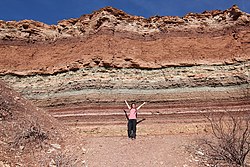
The image at the right shows rock strata in Cafayate, Argentina, the subject of stratigraphy.
Archaeology edit

Archaeology "studies human cultures through the recovery, documentation and analysis of material remains and environmental data, including architecture, artifacts, ecofacts, human remains, and landscapes."[83]
Historical geology edit

"Historical geology is a study of life forms represented in the fossil record, as well as the chronology of geologic processes."[84]
The image at the right shows two geochronologists and one paleontologist collecting ash at the Cretaceous-Paleogene Boundary in Wyoming, USA.
Geohistory edit

| Salé-Cypremort | 4600 years BP | |
| Cocodrie | 4600-3500 years BP | |
| Teche | 3500-2800 years BP | |
| St. Bernard | 2800-1000 years BP | |
| Lafourche | 1000-300 years BP | |
| Plaquemine | 750-500 years BP | |
| Balize | 550 years |
The image on the right shows the evolutionary history of the Mississippi delta.
Geohistory is the global evolution of the Earth.[85]
Quaternary edit


Def. the geology of the Quaternary period or system of deposits laid down during it is called Quaternary science.
The "whole change elapsed just opposite the course of events that characterized the great glacial oscillations with sudden warming followed by slow cooling. Therefore, the two phenomena hardly have the same cause."[86]
Seismology edit
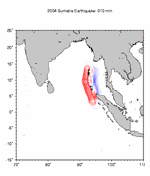
Seismology is the study of earthquakes and related phenomena through the use of Earth vibrations.
Geoseismology edit

Geoseismology is the study of vibration in the Earth.
Technology edit

"Satellite imagery and data from ground surveys are used to reconstruct the integrated pattern of the principal longitudinal and transverse features produced on a continent-wide scale by the last ice sheets in Europe and North America."[87]
"Boreholes [made by rigs like that imaged at the right] in Svalbard, Norway, for example, indicate that ground temperatures rose 0.4C over the past decade, four times faster than they did in the previous century".[88]"Three [Swarm] satellites of the European Space Agency (ESA) have measured the magnetic field of Earth more precisely than ever before."[89]
"Shinkai 6500, a Japanese research submarine built in 1989 [an artist's impression is on the left], can work at depths down to 6,400 m."[90]
"Scientists discovered the hot-springs ecosystems with the help of Alvin [imaged on the right, third one], the world's first deep-sea submersible. Constructed in the early 1960s for the U.S. Navy, Alvin is a three-person, self-propelling capsule-like submarine nearly eight meters long. In 1975, scientists of Project FAMOUS (French-American Mid-Ocean Undersea Study) used Alvin to dive on a segment of the Mid-Atlantic Ridge in an attempt to make the first direct observation of seafloor spreading. No hot springs were observed on this expedition; it was during the next Alvin expedition, the one in 1977 to the Galapagos Rift, that the hot springs and strange creatures were discovered. Since the advent of Alvin, other manned submersibles have been built and used successfully to explore the deep ocean floor. Alvin has an operational maximum depth of about 4,000 m, more than four times greater than that of the deepest diving military submarine."[90]
"The Glomar Challenger [imaged on the third right] was the first research vessel specifically designed in the late 1960s for the purpose of drilling into and taking core samples from the deep ocean floor."[90]
"In the years following World War II, continental oil reserves were being depleted rapidly and the search for offshore oil was on. To conduct offshore exploration, oil companies built ships equipped with a special drilling rig and the capacity to carry many kilometers of drill pipe. This basic idea later was adapted in constructing a research vessel, named the Glomar Challenger, designed specifically for marine geology studies, including the collection of drill-core samples from the deep ocean floor. In 1968, the vessel embarked on a year-long scientific expedition, criss-crossing the Mid-Atlantic Ridge between South America and Africa and drilling core samples at specific locations. When the ages of the samples were determined by paleontologic and isotopic dating studies, they provided the clinching evidence that proved the seafloor spreading hypothesis."[90]
"The JOIDES Resolution [in the fourth image on the right] is the deep-sea drilling ship of the 1990s (JOIDES= Joint Oceanographic Institutions for Deep Earth Sampling). This ship, which carries more than 9,000 m of drill pipe, is capable of more precise positioning and deeper drilling than the Glomar Challenger."[90]
Hypotheses edit
- The volcanoes of Earth may have the same origin as the volcanoes of Io.
- Many or all the folded, jumbled, and displaced strata were moved and structurally altered by glacial surging.
See also edit
References edit
- ↑ 1.0 1.1 Philip B. Gove, ed (1963). Webster's Seventh New Collegiate Dictionary. Springfield, Massachusetts: G. & C. Merriam Company. pp. 1221.
- ↑ Decay and Half Life. http://www.iem-inc.com/prhlfr.html. Retrieved 14 December 2009.
- ↑ Merrill, McElhinny & McFadden 1996, Chapter 5
- ↑ Tony Phillips (29 December 2003). Earth's Inconstant Magnetic Field. http://science.nasa.gov/science-news/science-at-nasa/2003/29dec_magneticfield/. Retrieved 27 December 2009.
- ↑ Marco Pasero (May 2017). The New IMA List of Minerals – A Work in Progress – Updated: May 2017. International Mineralogical Association – CNMNC (Commission on New Minerals Nomenclature and Classification). http://nrmima.nrm.se//imalist.htm. Retrieved 25 July 2017.
- ↑ Johan Jacobsen, Michelle Santos Rodrigues, Mark T. F. Telling, Antonio Ludovico Beraldo, Sérgio Francisco Santos, Laurence P. Aldridge, and Heloisa N. Bordallo (16 September 2013). "Nano-scale hydrogen-bond network improves the durability of greener cements". Scientific Reports 3: 2667. doi:10.1038/srep02667. https://www.ncbi.nlm.nih.gov/pmc/articles/PMC3773627/. Retrieved 2017-07-25.
- ↑ gem. San Francisco, California: Wikimedia Foundation, Inc. 16 November 2014. https://en.wiktionary.org/wiki/gem. Retrieved 4 January 2015.
- ↑ gemology. San Francisco, California: Wikimedia Foundation, Inc. 9 December 2014. https://en.wiktionary.org/wiki/gemology. Retrieved 4 January 2015.
- ↑ halogen. San Francisco, California: Wikimedia Foundation, Inc. 29 December 2014. https://en.wiktionary.org/wiki/halogen. Retrieved 4 January 2015.
- ↑ metal. San Francisco, California: Wikimedia Foundation, Inc. 2 January 2015. https://en.wiktionary.org/wiki/metal. Retrieved 4 January 2015.
- ↑ precious metal. San Francisco, California: Wikimedia Foundation, Inc. 10 January 2014. https://en.wiktionary.org/wiki/precious_metal. Retrieved 4 January 2015.
- ↑ rare earth. San Francisco, California: Wikimedia Foundation, Inc. 6 June 2014. https://en.wiktionary.org/wiki/rare_earth. Retrieved 4 January 2015.
- ↑ C. Frondel (1958). Systematic Mineralogy of Uranium and Thorium. United States Government Printing Office.
- ↑ silicate. San Francisco, California: Wikimedia Foundation, Inc. 17 December 2014. https://en.wiktionary.org/wiki/silicate. Retrieved 4 January 2015.
- ↑ Deer, W.A.; Howie, R.A., & Zussman, J. (1992). An introduction to the rock forming minerals (2nd edition ed.). London: Longman ISBN 0-582-30094-0
- ↑ Hurlbut, Cornelius S.; Klein, Cornelis (1985). Manual of Mineralogy, Wiley, (20th edition ed.). ISBN 0-471-80580-7
- ↑ metasilicate. San Francisco, California: Wikimedia Foundation, Inc. 20 June 2013. https://en.wiktionary.org/wiki/metasilicate. Retrieved 2 September 2013.
- ↑ transuranic. San Francisco, California: Wikimedia Foundation, Inc. 17 December 2014. https://en.wiktionary.org/wiki/transuranic. Retrieved 4 January 2015.
- ↑ 19.0 19.1 crystallography. San Francisco, California: Wikimedia Foundation, Inc. 29 August 2013. https://en.wiktionary.org/wiki/crystallography. Retrieved 2 September 2013.
- ↑ mineraloid. San Francisco, California: Wikimedia Foundation, Inc. 20 April 2011. http://en.wiktionary.org/wiki/mineraloid. Retrieved 23 October 2012.
- ↑ tektite. San Francisco, California: Wikimedia Foundation, Inc. 31 August 2012. http://en.wiktionary.org/wiki/tektite. Retrieved 23 October 2012.
- ↑ amber. San Francisco, California: Wikimedia Foundation, Inc. 19 December 2014. https://en.wiktionary.org/wiki/amber. Retrieved 9 January 2015.
- ↑ MacEachern, Scott (1996) "Iron Age beginnings north of the Mandara Mountains, Cameroon and Nigeria"] pp. 489–496 In Pwiti, Gilbert and Soper, Robert (editors) (1996) Aspects of African Archaeology: Proceedings of the Tenth Pan-African Congress University of Zimbabwe Press, Harare, Zimbabwe, ISBN 978-0-908307-55-5; here by Internet Archive on 11 March 2012
- ↑ Diop-Maes, Louise Marie (1996) "La question de l'Âge du fer en Afrique" ("The question of the Iron Age in Africa") Ankh 4/5: pp. 278–303, in French; here by Internet Archive on 25 January 2008
- ↑ Boswell, P. F. and Blanchard, Roland (1929) "Cellular structure in limonite" Economic Geology 24(8): pp. 791–796
- ↑ Northrop, Stuart A. (1959) "Limonite" Minerals of New Mexico (revised edition) University of New Mexico Press, Albuquerque, New Mexico, pp. 329–333 }}
- ↑ Constantinou, G. and Govett, G. J. S. (1972) "Genesis of sulphide deposits, ochre and umber of Cyprus" Transactions of the Institution of Mining and Metallurgy 81: pp. 34–46
- ↑ Justin Gould (18 July 2012). Earthquake Glossary - geology. Menlo Park, California USA: USGS. http://earthquake.usgs.gov/learn/glossary/?term=geology. Retrieved 3 December 2014.
- ↑ regolith. San Francisco, California: Wikimedia Foundation, Inc. 25 May 2014. https://en.wiktionary.org/wiki/regolith. Retrieved 4 January 2015.
- ↑ 30.0 30.1 30.2 30.3 Jonathan Amos (19 December 2016). Iron 'jet stream' detected in Earth's outer core. London, England: BBC. http://www.bbc.com/news/science-environment-38372342. Retrieved 11 January 2017.
- ↑ Chris Finlay (19 December 2016). Iron 'jet stream' detected in Earth's outer core. London, England: BBC. http://www.bbc.com/news/science-environment-38372342. Retrieved 11 January 2017.
- ↑ 32.0 32.1 Phil Livermore (19 December 2016). Iron 'jet stream' detected in Earth's outer core. London, England: BBC. http://www.bbc.com/news/science-environment-38372342. Retrieved 11 January 2017.
- ↑ Rainer Hollerbach (19 December 2016). Iron 'jet stream' detected in Earth's outer core. London, England: BBC. http://www.bbc.com/news/science-environment-38372342. Retrieved 11 January 2017.
- ↑ wikt:User:Vildricianus:Vildricianus (25 March 2006). region. San Francisco, California: Wikimedia Foundation, Inc. http://en.wiktionary.org/wiki/region. Retrieved 10 September 2012.
- ↑ orogeny. San Francisco, California: Wikimedia Foundation, Inc. 16 December 2014. https://en.wiktionary.org/wiki/orogeny. Retrieved 4 January 2015.
- ↑ gravity. San Francisco, California: Wikimedia Foundation, Inc. 26 August 2014. https://en.wiktionary.org/wiki/gravity. Retrieved 5 January 2015.
- ↑ J. P. Barringer's acceptance speech. Meteoritics, volume 28, page 9 (1993). Retrieved on the SAO/NASA Astrophysics Data System
- ↑ Grieve, R.A.F. (1990) Impact Cratering on the Earth, Scientific American 262(4), 66–73.
- ↑ landscape. San Francisco, California: Wikimedia Foundation, Inc. 6 October 2013. https://en.wiktionary.org/wiki/landscape. Retrieved 9 November 2013.
- ↑ noble gas. San Francisco, California: Wikimedia Foundation, Inc. 19 September 2013. https://en.wiktionary.org/wiki/noble_gas. Retrieved 5 October 2013.
- ↑ RP Esser, WC McIntosh, MT Heizler, PR Kyle (September 1997). "Excess argon in melt inclusions in zero-age anorthoclase feldspar from Mt. Erebus, Antarctica, as revealed by the 40Ar/39Ar method". Geochimica et Cosmochimica Acta 61 (18): 3789-3801. doi:10.1016/S0016-7037(97)00287-1. http://www.sciencedirect.com/science/article/pii/S0016703797002871. Retrieved 2012-10-13.
- ↑ hydrology. San Francisco, California: Wikimedia Foundation, Inc. 4 December 2014. https://en.wiktionary.org/wiki/hydrology. Retrieved 4 January 2015.
- ↑ Dmitry Solovyov (28 August 2007). Large increase in leakage of methane gas from the Arctic seabed. The We at WePlanet. http://www.thewe.cc/weplanet/news/arctic/permafrost_melting.htm#this_is_real. Retrieved 20 September 2014.
- ↑ Jane Beitler (2014). All About Snow. National Snow and Ice Data Center. http://nsidc.org/cryosphere/snow/index.html. Retrieved 17 September 2014.
- ↑ ocean. San Francisco, California: Wikimedia Foundation, Inc. 9 December 2014. https://en.wiktionary.org/wiki/ocean. Retrieved 16 December 2014.
- ↑ petroleum. San Francisco, California: Wikimedia Foundation, Inc. 16 July 2014. https://en.wiktionary.org/wiki/petroleum. Retrieved 9 January 2015.
- ↑ rocky. San Francisco, California: Wikimedia Foundation, Inc. 29 August 2012. http://en.wiktionary.org/wiki/rocky. Retrieved 23 October 2012.
- ↑ 48.0 48.1 48.2 terrain. San Francisco, California: Wikimedia Foundation, Inc. 7 October 2013. https://en.wiktionary.org/wiki/terrain. Retrieved 9 November 2013.
- ↑ geography. San Francisco, California: Wikimedia Foundation, Inc. 6 November 2013. https://en.wiktionary.org/wiki/geography. Retrieved 9 November 2013.
- ↑ 50.0 50.1 coal. San Francisco, California: Wikimedia Foundation, Inc. 1 January 2015. https://en.wiktionary.org/wiki/coal. Retrieved 1 January 2015.
- ↑ ice. San Francisco, California: Wikimedia Foundation, Inc. 29 December 2014. https://en.wiktionary.org/wiki/ice. Retrieved 1 January 2015.
- ↑ 52.0 52.1 Jane Beitler (2014). Cryosphere Glossary. National Snow and Ice Data Center. http://nsidc.org/cryosphere/glossary/I. Retrieved 17 September 2014.
- ↑ rock. San Francisco, California: Wikimedia Foundation, Inc. 23 October 2012. http://en.wiktionary.org/wiki/rock. Retrieved 23 October 2012.
- ↑ igneous rock. San Francisco, California: Wikimedia Foundation, Inc. 14 October 2014. https://en.wiktionary.org/wiki/igneous_rock. Retrieved 5 January 2015.
- ↑ magma. San Francisco, California: Wikimedia Foundation, Inc. 29 December 2014. https://en.wiktionary.org/wiki/magma. Retrieved 17 February 2015.
- ↑ diabase. San Francisco, California: Wikimedia Foundation, Inc. 16 December 2014. https://en.wiktionary.org/wiki/diabase. Retrieved 9 February 2015.
- ↑ metamorphism. San Francisco, California: Wikimedia Foundation, Inc. 16 December 2014. https://en.wiktionary.org/wiki/metamorphism. Retrieved 17 February 2015.
- ↑ blueschist. San Francisco, California: Wikimedia Foundation, Inc. 17 June 2013. https://en.wiktionary.org/wiki/blueschist. Retrieved 9 February 2015.
- ↑ 59.0 59.1 59.2 59.3 59.4 Essentials of Geology, 3rd Edition, Stephen Marshak
- ↑ metamorphic rock. San Francisco, California: Wikimedia Foundation, Inc. 7 December 2014. https://en.wiktionary.org/wiki/metamorphic_rock. Retrieved 5 January 2015.
- ↑ Raymond Siever, Sand, Scientific American Library, New York (1988), ISBN 0-7167-5021-X.
- ↑ P.E. Potter, J.B. Maynard, and P.J. Depetris, Mud and Mudstones: Introduction and Overview Springer, Berlin (2005) ISBN 3-540-22157-3.
- ↑ Georges Millot, translated [from the French] by W.R. Farrand, Helene Paquet, Geology Of Clays - Weathering, Sedimentology, Geochemistry Springer Verlag, Berlin (1970), ISBN 0-412-10050-9.
- ↑ Gary Nichols, Sedimentology & Stratigraphy, Wiley-Blackwell, Malden, MA (1999), ISBN 0-632-03578-1.
- ↑ sedimentary rock. San Francisco, California: Wikimedia Foundation, Inc. 23 December 2014. https://en.wiktionary.org/wiki/sedimentary_rock. Retrieved 5 January 2015.
- ↑ Tamentit meteorite at Meteoritical Bulletin Database.
- ↑ meteorite. San Francisco, California: Wikimedia Foundation, Inc. 14 February 2015. http://en.wiktionary.org/wiki/meteorite. Retrieved 28 March 2015.
- ↑ 68.0 68.1 68.2 68.3 68.4 68.5 68.6 Susan Taylor, Gregory F. Herzog, Gregory, Jeremy S. Delaney, (2007). "Crumbs from the crust of Vesta: Achondritic cosmic spherules from the South Pole water well". Meteoritics & Planetary Science 42 (2): 223-33. doi:10.1111/j.1945-5100.2007.tb00229.x.
- ↑ glaciology. San Francisco, California]: Wikimedia Foundation, Inc. 1 April 2014. https://en.wiktionary.org/wiki/glaciology. Retrieved 13 August 2014.
- ↑ 70.0 70.1 70.2 70.3 70.4 Robert S. Dietz and J. Paul Barringer (1973). "Hudson Bay Arc as an Astrobleme: a Negative Search". Meteoritics 8: 28-9. http://adsabs.harvard.edu/full/1973Metic...8...28D. Retrieved 2013-12-29.
- ↑ David W. Eaton, Fiona Darbyshire (January 5, 2010). "Lithospheric architecture and tectonic evolution of the Hudson Bay region". Tectonophysics 480 (1-4): 1-22. http://www.sciencedirect.com/science/article/pii/S0040195109005034. Retrieved 2013-12-30.
- ↑ speleology. San Francisco, California: Wikimedia Foundation, Inc. 17 December 2014. https://en.wiktionary.org/wiki/speleology. Retrieved 5 January 2015.
- ↑ earth science. San Francisco, California: Wikimedia Foundation, Inc. 6 September 2014. https://en.wiktionary.org/wiki/earth_science. Retrieved 5 January 2015.
- ↑ mining. San Francisco, California: Wikimedia Foundation, Inc. 16 December 2014. https://en.wiktionary.org/wiki/mining. Retrieved 5 January 2015.
- ↑ geochronology. San Francisco, California: Wikimedia Foundation, Inc. 16 December 2014. https://en.wiktionary.org/wiki/geochronology. Retrieved 4 January 2015.
- ↑ SemperBlotto (21 April 2005). geodesy. San Francisco, California: Wikimedia Foundation, Inc. https://en.wiktionary.org/wiki/geodesy. Retrieved 21 February 2015.
- ↑ Zigzig20s (16 January 2007). geodetics. San Francisco, California: Wikimedia Foundation, Inc. https://en.wiktionary.org/w/index.php?title=geodetics&action=history. Retrieved 21 February 2015.
- ↑ geognosy. San Francisco, California: Wikimedia Foundation, Inc. 23 August 2011. http://en.wiktionary.org/wiki/geognosy. Retrieved 6 June 2012.
- ↑ Lars Stixrude, Evgeny Waserman and Ronald Cohen (November 1997). "Composition and temperature of Earth's inner core". Journal of Geophysical Research (w:American Geophysical Union) 102 (B11): 24729–24740. doi:10.1029/97JB02125. http://www.agu.org/pubs/crossref/1997/97JB02125.shtml.
- ↑ geomorphology. San Francisco, California: Wikimedia Foundation, Inc. 7 October 2013. https://en.wiktionary.org/wiki/geomorphology. Retrieved 9 November 2013.
- ↑ paleontology book. San Francisco, California: Wikimedia Foundation, Inc. 8 March 2012. http://en.wiktionary.org/wiki/paleontology. Retrieved 22 July 2012.
- ↑ 82.0 82.1 physical geography. San Francisco, California: Wikimedia Foundation, Inc. 17 June 2013. https://en.wiktionary.org/wiki/physical_geography. Retrieved 5 January 2015.
- ↑ Crazedandinfused (6 September 2007). Topic:Archeology. http:https://www.duhoctrungquoc.vn/edu/index.php?lang=en&q=Topic:Archeology&diff=156532&oldid=155948. Retrieved 13 January 2013.
- ↑ JT Bradley. COUNTY JANUARY JULY HIGH LOW HIGH LOW Charlotte 74 51 Lee 74 52 Collier 76 52. library.fgcu.edu. http://library.fgcu.edu/caloo/wusdpt5.pdf. Retrieved 31 December 2011.
- ↑ Minoru Ozima (1987). Geohistory. Springer Berlin Heidelberg. pp. 166. doi:10.1007/978-3-642-71254-8. ISBN 978-3-540-16595-8. http://link.springer.com/book/10.1007/978-3-642-71254-8. Retrieved 16 January 2016.
- ↑ Willi Dansgaard (2005). The Department of Geophysics of The Niels Bohr Institute for Astronomy Physics and Geophysics at The University of Copenhagen Denmark. ed. Frozen Annals Greenland Ice Cap Research. Copenhagen, Denmark: Niels Bohr Institute. pp. 123. ISBN 87-990078-0-0. http://www.iceandclimate.nbi.ku.dk/publications/FrozenAnnals.pdf/. Retrieved 5 October 2014.
- ↑ G. S. Boulton, G. D. Smith, A. S. Jones and J. Newsome (June 1985). "Glacial geology and glaciology of the last mid-latitude ice sheets". Journal of the Geological Society 142 (3): 447-74. doi:10.1144/gsjgs.142.3.0447. http://jgs.lyellcollection.org/content/142/3/447.short. Retrieved 2014-06-23.
- ↑ Molly Bentley (29 December 2004). Earth's permafrost starts to squelch. the We. http://www.thewe.cc/weplanet/news/arctic/permafrost_melting.htm#this_is_real. Retrieved 20 September 2014.
- ↑ Christoph Seidler, translated by Anne-Marie de Grazia (19 June 2014). Earth's weakening magnetic field. Q-Mag.org. http://www.q-mag.org/earths-weakening-magnetic-field.html. Retrieved 21 October 2014.
- ↑ 90.0 90.1 90.2 90.3 90.4 J. M. Watson (24 June 1999). Exploring the deep ocean floor: Hot springs and strange creatures. Reston, Virginia USA: U. S. Geological Survey. http://pubs.usgs.gov/gip/dynamic/exploring.html. Retrieved 26 October 2014.
External links edit
- African Journals Online
- Bing Advanced search
- Google Books
- Google scholar Advanced Scholar Search
- International Astronomical Union
- JSTOR
- Lycos search
- NASA's National Space Science Data Center
- NCBI All Databases Search
- Office of Scientific & Technical Information
- PubChem Public Chemical Database
- Questia - The Online Library of Books and Journals
- SAGE journals online
- The SAO/NASA Astrophysics Data System
- Scirus for scientific information only advanced search
- Spacecraft Query at NASA
- SpringerLink
- Taylor & Francis Online
- Wiley Online Library Advanced Search
- Yahoo Advanced Web Search
Learn more about Geology |
